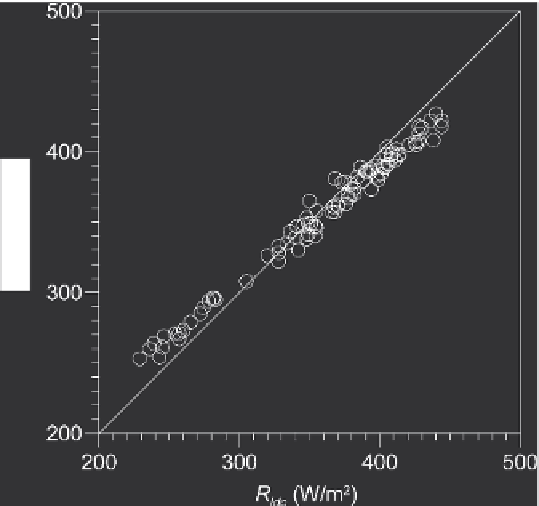Geoscience Reference
In-Depth Information
Fig. 2.24 Comparison between
measured longwave
radiation
R
ldcs
under
clear sky and radiation
R
ldc
estimated by means
of Equations (2.80) and
(2.81) with the original
constants
a
=
1
.
24 and
b
=
1
/
7. (From Sugita
and Brutsaert, 1993.)
R
ldc
(W m
−
2
)
where
T
a
is the air temperature near the ground, usually taken at shelter level, and
ε
ac
is
the atmospheric emissivity under clear skies.
Several expressions have been proposed for this emissivity. Most of these are strictly
empirical, but it is also possible to derive
ε
ac
from physical considerations. In one such
derivation (Brutsaert, 1975; 1982), the equation for radiative transfer in a plane stratified
atmosphere is solved by assuming first, a simple power function slab emissivity, and
second, a near-Standard Atmosphere to obtain the temperature and humidity profiles.
With typical average values of the parameters, the resulting atmospheric emissivity can
be written as
T
a
)
b
ε
ac
=
a
(
e
a
/
(2.81)
=
=
/
where
a
and
b
are constants; these were derived to be
a
1.24 and
b
1
7, when
=
the vapor pressure of the air
e
a
is in hPa (
mb) and
T
is in K. Equation (2.81) has
been found (see Mermier and Seguin, 1976; Aase and Idso, 1978; Daughtry
et al.
,
1990) to yield satisfactory results under conditions which, on average, are fairly well
represented by a Standard Atmosphere. With instantaneous measurements in the Great
Plains of the USA, Equation (2.81) with the original constants was also found to perform
well (see Figure 2.24), but somewhat better with values of the constants
a
=
0.980 and
b
0.0687 (Sugita and Brutsaert, 1993). Culf and Gash (1993) using the same derivation
of (2.81) as in Brutsaert (1975), but with actually recorded profiles (instead of a Standard
Atmosphere), obtained
a
=
7 for the dry season in Niger. Crawford
and Duchon (1999) were able to improve the performance of (2.81) with
b
=
1.31 and
b
=
1
/
=
1
/
7in

